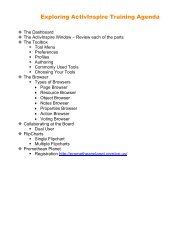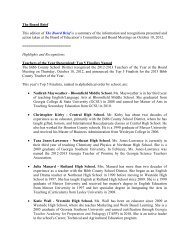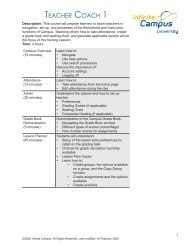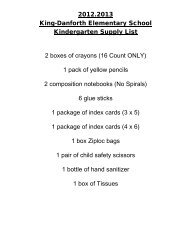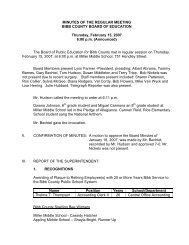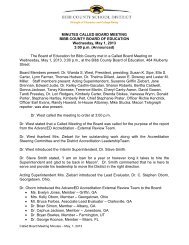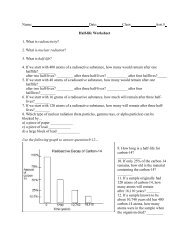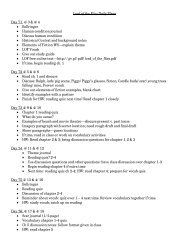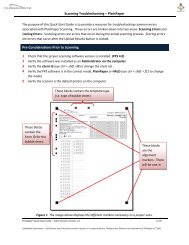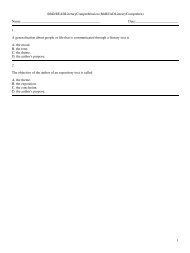9 Grade Literature and Composition – Pacing Guide 2011-2012
9 Grade Literature and Composition – Pacing Guide 2011-2012
9 Grade Literature and Composition – Pacing Guide 2011-2012
You also want an ePaper? Increase the reach of your titles
YUMPU automatically turns print PDFs into web optimized ePapers that Google loves.
1<br />
9 th <strong>Grade</strong> <strong>Literature</strong> <strong>and</strong> <strong>Composition</strong> <strong>–</strong> <strong>Pacing</strong> <strong>Guide</strong> <strong>2011</strong>-<strong>2012</strong><br />
Of the many themes found in literature, this guide focuses on four. While the chart places these themes during specific times of the school year <strong>and</strong> with individual works of<br />
literature, this organization should not be considered a limitation. Works of literature, of course, contain many themes, <strong>and</strong>, when a piece is studied, students should be guided to<br />
explore all possible themes. Themes should be posted on classroom walls, so that they can be emphasized <strong>and</strong> then revisited when teachable moments occur. It should also be<br />
noted that, except for the required The Tragedy of Romeo <strong>and</strong> Juliet <strong>and</strong> The Odyssey, all other listed works are suggestions. Clearly, not all of the readings can be examined in the<br />
allotted time frames, <strong>and</strong> student readiness should be the criteria upon which the teacher determines the breadth of materials to be used. Finally, for a broader selection of longer<br />
works of literature, teachers should reference the Bibb County novel list that is organized by grade level. Having students choose their own novels from the library would also be<br />
another way to support students’ achievement of the Georgia Performance St<strong>and</strong>ards.<br />
August/January September/February October/March November/December<br />
April/May<br />
Suggested Theme The Journey Inward Justice/Injustice Individual in Society Hero Cycle<br />
Reading<br />
(Lesson on themes<br />
should be given at<br />
the beginning of<br />
each new semester)<br />
Writing<br />
(Reference the<br />
Bibb County<br />
Required Writing<br />
Document)<br />
Conventions<br />
(to be taught within<br />
the context of<br />
reading, writing, <strong>and</strong><br />
speaking)<br />
(Suggested)<br />
A Separate Peace<br />
(or Great Expectations or The Chosen)<br />
(novels)<br />
I Know Why the Caged Bird Sings<br />
(memoir)<br />
“Marigolds” (ss)<br />
“Where Have You Gone Charming<br />
Billy” (ss)<br />
“Caged Bird” (poem)<br />
“An Interview” by G. Plimpton<br />
(interview)<br />
“The Road Not Taken” (poem)<br />
“Young” (poem)<br />
“Hanging Fire” (poem)<br />
“Sympathy” by Dunbar (poem)<br />
“The Bass, the River, <strong>and</strong> Sheila Mant”<br />
(ss)<br />
1. Timed writing- persuasive (system<br />
wide)<br />
2. Interview (assume character or<br />
preparing for proposal<br />
3. “About Me” or “School Service”<br />
Flyer<br />
4. Synthesizing 2 per week in journaling<br />
or test essay question<br />
ELA9C1a<br />
ELA9C2 a-d<br />
LSV Socratic Seminar<br />
<strong>Literature</strong> Circles<br />
ELA9LSV2<br />
(Suggested)<br />
To Kill a Mockingbird (novel)<br />
“The Most Dangerous Game” (ss)<br />
“Harlem” (poem by Hughes)<br />
“The Possibility of Evil” (ss)<br />
Black Boy (autobiography<br />
excerpt)<br />
Trifles (play)<br />
The Devil <strong>and</strong> Daniel Webster<br />
(play)<br />
“I Have a Dream” (speech)<br />
“Glory <strong>and</strong> Hope” (speech)<br />
“Only Daughter” (essay)<br />
5. Timed writing <strong>–</strong> persuasive<br />
(include anecdote, ex. New<br />
ending to a literary work.)<br />
6. Proposal with presentation<br />
7. Synthesizing; journal<br />
writing<br />
(Proposal sample will be linked<br />
in following pages)<br />
ELA9C1b<br />
ELA9C2 a-d<br />
ELA9LSV1<br />
Proposal<br />
ELA9LSV2<br />
C/C Most Dangerous Game/To<br />
Kill a Mockingbird<br />
Socratic Seminar<br />
The Tragedy of Romeo <strong>and</strong> Juliet (play) [Required]<br />
(Suggested)<br />
“The Scarlet Ibis” (ss)<br />
“The Sniper” (ss)<br />
“The Necklace” (ss)<br />
“Theme for English B” (poem)<br />
8. Compare/Contrast (expository) Synthesizing R<br />
& J multiple versions of the work<br />
9. Persuasive <strong>–</strong> R&J Blame essay<br />
10. Newsletter <strong>–</strong> cover event of R&J<br />
11. Synthesizing<br />
ELA9C1c<br />
ELA9C2 a-d<br />
C/C R&J Play with Videos<br />
Zefferelli/Luhrman/Westside Story/”Romeo <strong>and</strong><br />
Juliet Are Palestinian <strong>and</strong> Jewish”<br />
Socratic Seminar<br />
The Odyssey (epic poem) [Required]<br />
(Suggested)<br />
“Siren’s Song” (poem)<br />
“Penelope” (poem)<br />
“Ithaka” (poem)<br />
“Ulysses” Tennyson (poem)<br />
“Curiosity” Reed (poem)<br />
12. Expository <strong>–</strong> culminating activity<br />
on work not already read<br />
ELA9C1a-c<br />
ELA9C2 a-d<br />
Rocket Video <strong>–</strong><br />
Summary/Analysis/Quiz<br />
Socratic Seminar
9 th <strong>Grade</strong> <strong>Literature</strong> <strong>and</strong> <strong>Composition</strong> Samples Lessons/Tasks/Culminating Assessments<br />
1. 9 th grade ELA Culminating Assessments for each st<strong>and</strong>ard are listed at the end of most GPS. A sample list of st<strong>and</strong>ards <strong>and</strong> their<br />
assessments for a fiction unit is listed below. Required writing pieces have been incorporated as well. This sample can be adjusted as needed<br />
for each unit.<br />
ELA9RL1 sample task: study guide for a work of fiction<br />
ELA9RL2 sample task: timed writing for a work of fiction on theme. (also ELARL4, ELA9W1)<br />
ELA9RL2d: timed writing to compare <strong>and</strong> contrast the presentation of a theme across genres. (also ELARL4, BCSD Expository Writing:<br />
Synthesizing Writing Activity)<br />
ELA9RL1, ELA9RL2: Analysis of literary devices in short stories (also ELA9W1, BCSD Expository Writing)<br />
ELA9RL1,ELA9RL2, RLA9RL3: Expository Journal Writing (BCSD Expository Writing)<br />
ELA9RL3: Choose a work or works <strong>and</strong> have students complete a web quest to relate the work(s) to the literary period <strong>and</strong> /or historical setting.<br />
ELA9RL4 sample task: The student composes an original piece of literature that follows the structure of a given literary work. (see also ELA9RL2<br />
<strong>and</strong> ELA9RL2d)<br />
ELA9RL5: Students identify words with whose meanings they are unfamiliar <strong>and</strong> use context clues <strong>and</strong> reference materials to determine the<br />
meanings in the passage.<br />
ELA9RC1 sample task: Students read a novel <strong>and</strong> in small groups create a product that reflects the tone <strong>and</strong> underlying meaning(s) of the work.<br />
(also ELA9RL1)<br />
RLA9RC2 <strong>and</strong> ELARC4 sample task: After reading a work of fiction that includes a theme related to an issue relevant to today’s world, students<br />
engage in a discussion format. (also ELA9RL2)<br />
ELA9RC3 sample task: The student composes an essay that defines <strong>and</strong> explains a new word that has entered the lexicon in the past twenty years.<br />
(also ELA9RL5, BCSD Expository Writing)<br />
ELA9W1 sample task: The student writes a new ending to a literary work. (also ELA9RL1, BCSD Narrative Genre)<br />
ELA9W2, ELA9W3 sample task: The students conduct <strong>and</strong> present the findings of original, primary research. (also ELA9LSV1, ELA9LSV2,<br />
BCSD Technical Writing)<br />
ELA9W4 sample task: The student composes an essay that compares <strong>and</strong> contrasts different entities or ideas. (also ELA9RL1, ELA9RL2, BSCD<br />
Expository Writing)<br />
ELA9W4: Bibb system-wide timed persuasive writing (also ELA9W1, ELA9W2, BSCD Persuasive Writing)<br />
ELA9C1, ELA9C2: Conventions are assessed within the context of the other str<strong>and</strong>s.<br />
ELA9LSV1 sample task: The student engages in a Socratic seminar or other discussion format. (also ELA9RL1, ELA9RL2, ELA9RL3, ELA9RC2)<br />
ELA9LSV2 sample task: The student compares <strong>and</strong> contrasts multiple versions of a text. (also ELA9RL1, ELA9RL2, ELA9RL3, ELA9RL4,<br />
ELA9W1, ELA9W2, ELA9W3, BCSD Expository Writing: Synthesizing Writing Activity)<br />
2
9 th <strong>Grade</strong> <strong>Literature</strong> <strong>and</strong> <strong>Composition</strong> Samples Lessons/Tasks/Culminating Assessments (cont.)<br />
2. A collection of sample lessons are found on the GeorgiaSt<strong>and</strong>ards.org website.<br />
https://www.georgiast<strong>and</strong>ards.org/St<strong>and</strong>ards/Georgia%20Performance%20St<strong>and</strong>ards/<strong>Grade</strong>-9.pdf<br />
3. Links to Lessons that address the 9 th <strong>Grade</strong> ELA <strong>Pacing</strong> <strong>Guide</strong> themes/works are organized below:<br />
The Journey Inward<br />
Spend a Day in My Shoes: Exploring the Role of Perspective in Narrative (To Kill a Mockingbird)<br />
http://www.readwritethink.org/lessons/lesson_view.asp?id=265<br />
Teaching Plot Structure through Short Stories (Plot Pyramid)<br />
http://www.readwritethink.org/lessons/lesson_view.asp?id=401<br />
Justice/Injustice<br />
“I Have a Dream” (speech)<br />
http://ericir.syr.edu/cgi-bin/printlessons.cgi/Virtual/Lessons/Language_Arts/<strong>Literature</strong>/LIT0004.html<br />
Exploring the Power of Martin Luther King, Jr.’s Words through Diamante Poetry<br />
http://www.readwritethink.org/lessons/lesson_view.asp?id=258<br />
“The Possibility of Evil”<br />
http://www.macomb.k12.mi.us/EASTDET/Plans/HS-theme.htm<br />
“The Necklace”<br />
http://www.charlottemattison.com/thenecklace.htm<br />
Writing Technical Instructions<br />
http://www.readwritethink.org/lessons/lesson_view.asp?id=1101<br />
The Individual in Society<br />
Shakespeare (Iambic pentameter)<br />
http://ericir.syr.edu/cgi-bin/printlessons.cgi/Virtual/Lessons/Language_Arts/<strong>Literature</strong>/LIT0002.html<br />
Intro. To Shakespeare Lesson<br />
http://www.readwritethink.org/lessons/lesson_view.asp?id=1120<br />
Star-Crossed Lovers Online: Romeo <strong>and</strong> Juliet for a Digital Age (Showing Underst<strong>and</strong>ing)<br />
http://www.readwritethink.org/lessons/lesson_view.asp?id=857<br />
Tragic Love: Introducing Shakespeare’s Romeo <strong>and</strong> Juliet (Tragedy defined, plot, Themes)<br />
http://www.readwritethink.org/lessons/lesson_view.asp?id=1162<br />
3
Links to Lessons that address the 9 th <strong>Grade</strong> ELA <strong>Pacing</strong> <strong>Guide</strong> themes/works (cont.)<br />
Hero Cycle<br />
Preparing for the Journey: An Introduction to the Hero Myth (Intro. To The Odyssey)<br />
http://www.readwritethink.org/lessons/lesson_view.asp?id=1152<br />
Heroes Are Made of This: Studying the Character of Heroes<br />
http://www.readwritethink.org/lessons/lesson_view.asp?id=784<br />
Weaving the Old into the New: Pairing The Odyssey with Contemporary Works<br />
(characteristics of an epic <strong>and</strong> more)<br />
http://www.readwritethink.org/lessons/lesson_view.asp?id=1041<br />
4
9 th <strong>Grade</strong> <strong>Literature</strong> <strong>and</strong> <strong>Composition</strong> Samples Lessons/Tasks/Culminating Assessments (cont.)<br />
4. Links to lessons that are applicable to all themes/works/st<strong>and</strong>ards<br />
Fiction/Non-Fiction<br />
Analyzing Characters in 3 different Stories<br />
http://www.readwritethink.org/lessons/lesson_view.asp?id=1006<br />
Analyzing Character Using Headstone Activity<br />
http://www.readwritethink.org/lessons/lesson_view.asp?id=956<br />
Transferring from One Genre to Brochures<br />
http://www.readwritethink.org/lessons/lesson_view.asp?id=1002<br />
Creating Character Blogs<br />
http://www.readwritethink.org/lessons/lesson_view.asp?id=1169<br />
Creative Outlining/ Writing About Short Stories<br />
http://www.readwritethink.org/lessons/lesson_view.asp?id=1071<br />
Critical Reading: Comparing 2 Stories<br />
http://www.readwritethink.org/lessons/lesson_view.asp?id=213<br />
Before, During, <strong>and</strong> After Reading Activities<br />
http://www.readwritethink.org/lessons/lesson_view.asp?id=256<br />
Setting, Character, POV, Atmosphere, Theme<br />
http://www.readwritethink.org/lessons/lesson_view.asp?id=1094<br />
Focus on First Lines: Increasing Comprehension through Prediction Strategies<br />
http://www.readwritethink.org/lessons/lesson_view.asp?id=834<br />
Graffiti Wall: Discussing <strong>and</strong> Responding to <strong>Literature</strong> Using Graphics<br />
http://www.readwritethink.org/lessons/lesson_view.asp?id=208<br />
In <strong>Literature</strong>, Interpretation is the Thing (Critical Analysis)<br />
http://www.readwritethink.org/lessons/lesson_view.asp?id=818<br />
5
Links to lessons that are applicable to all themes/works/st<strong>and</strong>ards (Fiction/Non-fiction cont.)<br />
Literary Scrapbooks Online: An Electronic Reader-Response Project<br />
http://www.readwritethink.org/lessons/lesson_view.asp?id=787<br />
Name That Chapter! Discussing Summary <strong>and</strong> Interpretation Using Chapter Titles<br />
http://www.readwritethink.org/lessons/lesson_view.asp?id=197<br />
Teaching Plot Structure through Short Stories (Plot Pyramid)<br />
http://www.readwritethink.org/lessons/lesson_view.asp?id=401<br />
Word Maps: Developing Critical <strong>and</strong> Analytical Thinking About Literary Characters (characterization)<br />
http://www.readwritethink.org/lessons/lesson_view.asp?id=773<br />
<strong>Literature</strong> Circles<br />
http://litsite.alaska.edu/workbooks/circlereading.html<br />
Socratic Seminar<br />
http://www.greece.k12.ny.us/instruction/ela/SocraticSeminars/overview.htm<br />
Novel News: Broadcast Coverage of Character, Conflict, Resolution, <strong>and</strong> Setting<br />
http://www.readwritethink.org/lessons/lesson_view.asp?id=199<br />
Short Story Fair: Responding to Short Stories in Multiple Media <strong>and</strong> Genres<br />
http://www.readwritethink.org/lessons/lesson_view.asp?id=418<br />
Drama<br />
Create a Resume for a Character in a Play<br />
http://www.readwritethink.org/lessons/lesson_view.asp?id=198<br />
Choral Reading to Explore Theme <strong>and</strong> Character in Drama<br />
http://www.readwritethink.org/lessons/lesson_view.asp?id=1121<br />
Happily Ever After? Exploring Character, Conflict, <strong>and</strong> Plot in Dramatic Tragedy<br />
http://www.readwritethink.org/lessons/lesson_view.asp?id=374<br />
6
Links to lessons that are applicable to all themes/works/st<strong>and</strong>ards (cont.)<br />
Poetry<br />
Poetry Analysis: Historical Connection, Analysis, <strong>and</strong> Writing<br />
http://www.readwritethink.org/lessons/lesson_view.asp?id=251<br />
Introduction to Poetry Through Concrete Poems<br />
http://www.readwritethink.org/lessons/lesson_view.asp?id=211<br />
Exploring the Sonnet<br />
http://www.readwritethink.org/lessons/lesson_view.asp?id=830<br />
Is a Sentence a Poem? (Poetry Analysis <strong>and</strong> Writing)<br />
http://www.readwritethink.org/lessons/lesson_view.asp?id=246<br />
Onomatopoeia: A Figurative Language Mini-lesson<br />
http://www.readwritethink.org/lessons/lesson_view.asp?id=909<br />
Poetry: Sound <strong>and</strong> Sense (Poetic Devices)<br />
http://www.readwritethink.org/lessons/lesson_view.asp?id=848<br />
Sonic Patterns: Exploring Poetic Techniques Through Close Reading (“Those Winter Sundays)<br />
http://www.readwritethink.org/lessons/lesson_view.asp?id=1157<br />
Writing<br />
Persuasive Letter Writing/Audience<br />
http://www.readwritethink.org/lessons/lesson_view.asp?id=198<br />
Comparing a Literary Work to Its Video Version<br />
http://www.readwritethink.org/lessons/lesson_view.asp?id=1048<br />
Literary Parodies: Exploring a Writer’s Style through Imitation<br />
http://www.readwritethink.org/lessons/lesson_view.asp?id=839<br />
Technical Writing Sample<br />
http://schools.bibb.k12.ga.us/166120912102150480/blank/browse.asp?A=383&BMDRN=2000&BCOB=0&C=71758<br />
7
5. Links to Activities that support all st<strong>and</strong>ards/themes/units<br />
Before Reading Activities<br />
Webquest Resources<br />
http://webquest.org/search/index.php<br />
http://school.discoveryeducation.com/schrockguide/webquest/webquest.html<br />
http://www.techtrekers.com/webquests/<br />
http://www.thirteen.org/edonline/concept2class/webquests/index.html<br />
http://www.teachersfirst.com/summer/webquest/quest-a.shtml<br />
Graphic Organizers<br />
http://www.eduplace.com/graphicorganizer/<br />
http://edhelper.com/teachers/graphic_organizers.htm<br />
http://www.enchantedlearning.com/graphicorganizers/<br />
http://www.region15.org/curriculum/graphicorg.html<br />
http://www.k111.k12.il.us/LAFAYETTE/FOURBLOCKS/graphic_organizers.htm<br />
Anticipation <strong>Guide</strong>s<br />
http://www.greece.k12.ny.us/instruction/ela/6-12/reading/Reading%20Strategies/anticipation%20guide.htm<br />
http://www.adlit.org/strategies/19712<br />
http://www.education-world.com/a_lesson/dailylp/dailylp/dailylp067.shtml<br />
teachingtoday.glencoe.com/userfiles/file/anticipation_guide.pdf<br />
During Reading Activities<br />
DR-TA Prediction <strong>Guide</strong> (Directed Reading-Thinking Activities)<br />
http://www.learningpt.org/literacy/adolescent/strategies/drta.php<br />
<strong>Guide</strong>d Reading Procedure<br />
http://literacy.kent.edu/Oasis/Pubs/burns.html<br />
arslpedconsultant.com/documents/H<strong>and</strong>outs%20Classroom%20Intervention/<strong>Guide</strong>d%20Reading%<br />
http://olc.spsd.sk.ca/DE/PD/instr/strats/guided/guided.html<br />
Jot Charts<br />
http://www.justreadnow.com/strategies/jot.htm<br />
8
Links to Activities to support all st<strong>and</strong>ards/themes/units (cont.)<br />
Pattern <strong>Guide</strong>s<br />
http://www.smasd.org/pssa/html/reading/rih<strong>and</strong>14.htm<br />
Venn Diagram<br />
http://buckeyevalley.schoolwires.com/731610627134223540/lib/731610627134223540/BiographyVennDiagramTemplate_l<strong>and</strong>scape.doc<br />
QAR (Question-Answer Relationship)<br />
http://www.greece.k12.ny.us/instruction/ela/6-12/Reading/Reading%20strategies/QAR.htm<br />
<strong>Guide</strong>-O-Rama<br />
www5.esc13.net/science/docs/<strong>Guide</strong>-O-Rama.<br />
hercules.gcsu.edu/~cbader/5210SPED/guideorama.htm<br />
Marginal Gloss<br />
http://www.assistivetechnology.vcu.edu/2006/07/marginal_gloss_i_can_read_it_i.html<br />
Reflection Activities<br />
Trip Cards<br />
http://www.pdp.salford.ac.uk/resources/pdpmaterials/1<br />
Exit Cards<br />
http://www.saskschools.ca/curr_content/mathcatch/mainpages/assess_tools/exit_cards1.html<br />
Text Lookbacks<br />
http://www.interventioncentral.org/htmdocs/interventions/rdngcompr/txtlkbk.php<br />
Post Graphic Organizers<br />
http://www.k111.k12.il.us/LAFAYETTE/FOURBLOCKS/graphic_organizers.htm<br />
Revised June 22, 2009, 1:50pm<br />
9



